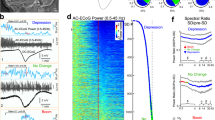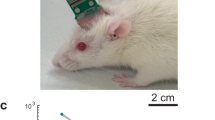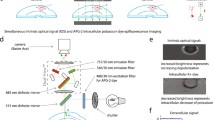Abstract
In cerebral cortex of anesthetized rats single waves of spreading depolarization (CSD) were elicited by needle prick. CSD-related changes of DC (direct current) potentials were either recorded from the intact skin or together with concomitant changes of potassium concentration with K+-selective microelectrodes simultaneously at the surface of the dura mater or of the cortex ([K+]s) and in the extracellular space at a cortical depth of 1200 µm. At the intact skin CSD-related DC-shifts had amplitudes of less than 1 mV and had only in a minority of cases the typical CSD-like shape. In the majority these DC-shifts rose and recovered very slowly and were difficult to identify without further indicators. At dura surface CSD-related DC shifts were significantly smaller and rose and recovered slower than intracortically recorded CSD. Concomitant increases in [K+]s were delayed and reached maximal values of about 5 mM from a baseline of 3 mM. They rose and recovered slower than simultaneously recorded intracortical changes in extracellular potassium concentration ([K+]e) that were up to 65 mM. The results suggest that extracellular potassium during CSD is diffusing through the subarachnoid space and across the dura mater. In a few cases CSD was either absent at the dura or at a depth of 1200 µm. Even full blown CSDs in this cortical depth could remain without concomitant deflections at the dura. Our data confirmed in principle the possibility of non-invasive recordings of CSD-related DC-shifts. For a use in clinical routine sensitivity and specificity will have to be improved.





Similar content being viewed by others
References
Leaõ AAP (1944) Spreading depression of activity in the cerebral cortex. J Neurophysiol 7:359–390
Van Harreveld A, Hawes RC (1946) Asphyxial depolarisation in the spinal cord. Am J Physiol 147:669–684
Leaõ AAP (1947) Further observations on the spreading depression of activity in the cerebral cortex. J Neurophysiol 10:409–414
Van Harreveld A, Kooiman M (1965) Amino acid release from the cerebral cortex during spreading depression and asphyxiation. J Neurochem 12:431–439
Van Harreveld FE (1970) Glutamate release from the retina during spreading depression. J Neurobiol 2:13–29
Somjen GG, Aitken PG, Czéh GL, Herreras O, Jing J, Young JN (1992) Mechanism of spreading depression: a review of recent findings and a hypothesis. Can J Physiol Pharmacol 70 Suppl:S248–S254
Gardner-Medwin AR (1983) Analysis of potassium dynamics in mammalian brain tissue. J Physiol 335:393–426
Nicholson C, Kraig RP (1981) The behavior of extracellular ions during spreading depression. In: Zeuthen E (ed) The application of ion-selective microelectrodes. Elsevier, Amsterdam, pp 217–238
Vyskočil F, Křiž N, Bureš J (1972) Potassium-selective microelectrodes used for measuring the extracellular brain potassium during spreading depression and anoxic depolarization in rats. Brain Res 39:255–259
Somjen GG (2001) Mechanisms of spreading depression and hypoxic spreading depression-like depolarization. Physiol Rev 81:1065–1096
Dreier JP (2011) The role of spreading depression, spreading depolarization and spreading ischemia in neurological disease. Nat Med 17:439–447
Nedergaard M, Hansen AJ (1988) Spreading depression is not associated with neuronal injury in the normal brain. Brain Res 449:395–398
Donkin JJ, Vink R (2010) Mechanisms of cerebral edema in traumatic brain injury: therapeutic developments. Curr Opin Neurol 23:293–299
Bureš J, Burešova O, Křivanek J (1974) The mechanism and applications of Leão’s spreading depression of electroencephalographic activity. Academia, Prague
Gardner-Medwin AR, Mutch WAC (1984) Experiments on spreading depression in relation to migraine and neurosurgery. An Acad Bras Cienc 56:423–430
Lauritzen M (1987) Cortical spreading depression as a putative migraine mechanism. Trends Neurosci 10:8–13
Lauritzen M (1994) Pathophysiology of the migraine aura. The spreading depression theory. Brain 117:199–210
Mayevsky A, Doron A, Manor T, Meilin S, Zarchin N, Ouaknine GE (1996) Cortical spreading depression recorded from the human brain using a multiparametric monitoring system. Brain Res 740:268–274
Sramka M, Brozek G, Bures J, Nádvorník P (1977–1978) Functional ablation by spreading depression: possible use in human stereotactic neurosurgery. Appl Neurophysiol 40:48–61
Oka H, Kako M, Matsushima M, Ando K (1977) Traumatic spreading depression syndrome. Review of a particular type of head injury in 37 patients. Brain 100:287–298
Bowyer SM, Aurora KS, Moran JE, Tepley N, Welch KM (2001) Magnetoencephalographic fields from patients with spontaneous and induced migraine aura. Ann Neurol 50:582–587
Strong AJ, Fabricius M, Boutelle MG, Hibbins SJ, Hopwood SE, Jones R, Parkin MC, Lauritzen M (2002) Spreading and synchronous depressions of cortical activity in acutely injured human brain. Stroke 33:2738–2743
Hossmann KA (1996) Periinfarct depolarizations. Cerebrovasc Brain Metab Rev 8:195–208
Hartings JA, Bullock MR, Okonkwo DO, Murray LS, Murray GD, Fabricius M, Maas AI, Woitzik J, Sakowitz O, Mathern B, Roozenbeek B, Lingsma H, Dreier JP, Puccio AM, Shutter LA, Pahl C, Strong AJ, Co-Operative Study on Brain Injury Depolarisations (2011) Spreading depolarisations and outcome after traumatic brain injury: a prospective observational study. Lancet Neurol 10:1058–1064
Dreier JP, Fabricius M, Ayata C, Sakowitz OW, William Shuttleworth C, Dohmen C, Graf R, Vajkoczy P, Helbok R, Suzuki M, Schiefecker AJ, Major S, Winkler MK, Kang EJ, Milakara D, Oliveira-Ferreira AI, Reiffurth C, Revankar GS, Sugimoto K, Dengler NF, Hecht N, Foreman B, Feyen B, Kondziella D, Friberg CK, Piilgaard H, Rosenthal ES, Westover MB, Maslarova A, Santos E, Hertle D, Sánchez-Porras R, Jewell SL, Balança B, Platz J, Hinzman JM, Lückl J, Schoknecht K, Schöll M, Drenckhahn C, Feuerstein D, Eriksen N, Horst V, Bretz JS, Jahnke P, Scheel M, Bohner G, Rostrup E, Pakkenberg B, Heinemann U, Claassen J, Carlson AP, Kowoll CM, Lublinsky S, Chassidim Y, Shelef I, Friedman A, Brinker G, Reiner M, Kirov SA, Andrew RD, Farkas E, Güresir E, Vatter H, Chung LS, Brennan KC, Lieutaud T, Marinesco S, Maas AI, Sahuquillo J, Dahlem MA, Richter F, Herreras O, Boutelle MG, Okonkwo DO, Bullock MR, Witte OW, Martus P, van den Maagdenberg AM, Ferrari MD, Dijkhuizen RM, Shutter LA, Andaluz N, Schulte AP, MacVicar B, Watanabe T, Woitzik J, Lauritzen M, Strong AJ, Hartings JA (2017) Recording, analysis, and interpretation of spreading depolarizations in neurointensive care: review and recommendations of the COSBID research group. J Cereb Blood Flow Metab 37:1595–1625
Woitzik J, Pinczolits A, Hecht N, Sandow N, Scheel M, Drenckhahn C, Dreier JP, Vajkoczy P (2014) Excitotoxicity and metabolic changes in association with infarct progression. Stroke 45:1183–1185
Lauritzen M, Strong AJ (2017) ‘Spreading depression of Leão’ and its emerging relevance to acute brain injury in humans. J Cereb Blood Flow Metab 37:1553–1570
Dreier JP, Lemale CL, Kola V, Friedman A, Schoknecht K (2018) Spreading depolarization is not an epiphenomenon but the principal mechanism of the cytotoxic edema in various gray matter structures of the brain during stroke. Neuropharmacology 134(Pt B):189–207
Nicholson C (1993) Ion-selective microelectrodes and diffusion measurements as tools to explore the brain cell microenvironment. J Neurosci Meth 48:199–213
Phi JH, Lee SJ, Kang HS, Kim JE, Kim SK, Cho WS, Lee SY (2018) Postoperative transient neurologic dysfunction: a proposal for pathophysiology. J Clin Neurol 14:393–400
Leistner S, Sander T, Wachs M, Burghoff M, Curio G, Trahms L, Mackert BM (2009) Differential infraslow (< 0.1 Hz) cortical activations in the affected and unaffected hemispheres from patients with subacute stroke demonstrated by noninvasive DC-magnetoencephalography. Stroke 40:1683–1686
Leistner S, Sander-Thoemmes T, Wabnitz H, Moeller M, Wachs M, Curio G, Macdonald R, Trahms L, Mackert BM (2011) Non-invasive simultaneous recording of neuronal and vascular signals in subacute ischemic stroke. Biomed Tech (Berl) 56:85–90
Kohl M, Lindauer U, Dirnagl U, Villringer A (1998) Separation of changes in light scattering and chromophore concentrations during cortical spreading depression in rats. Opt Lett 23:555–557
Ayata C (2018) Monitoring anoxic depolarization at the bedside: A step closer to the 24th century. J Cereb Blood Flow Metab 38:1123–1124
Carlson AP, Shuttleworth CW, Major S, Lemale CL, Dreier JP, Hartings JA (2018) Terminal spreading depolarizations causing electrocortical silencing prior to clinical brain death: case report. J Neurosurg 1:1–7 https://doi.org/10.3171/2018.7.JNS181478
Hartings JA, Wilson JA, Hinzman JM, Pollandt S, Dreier JP, DiNapoli V, Ficker DM, Shutter LA, Andaluz N (2014) Spreading depression in continuous electroencephalography of brain trauma. Ann Neurol 76:681–694
Drenckhahn C, Winkler MK, Major S, Scheel M, Kang EJ, Pinczolits A, Grozea C, Hartings JA, Woitzik J, Dreier JP, COSBID study group (2012) Correlates of spreading depolarization in human scalp electroencephalography. Brain 135(Pt 3):853–868
Malmivuo JA, Suihko VE (2004) Effect of skull resistivity on the spatial resolutions of EEG and MEG. IEEE Trans Biomed Eng 51:1276–1280
Pradhan AA, Smith ML, Zyuzin J, Charles A (2014) δ-Opioid receptor agonists inhibit migraine-related hyperalgesia, aversive state and cortical spreading depression in mice. Br J Pharmacol 171:2375–2584
Houben T, Loonen IC, Baca SM, Schenke M, Meijer JH, Ferrari MD, Terwindt GM, Voskuyl RA, Charles A, van den Maagdenberg AM, Tolner EA (2017) Optogenetic induction of cortical spreading depression in anesthetized and freely behaving mice. J Cereb Blood Flow Metab 37:1641–1655
Heinemann U, Lux HD (1977) Ceiling of stimulus induced rises in extracellular potassium concentration. Brain Res 120:231–249
Sadanaga KK, Ohnishi ST (1990) Studies on the permeability of potassium ions across the dura and arachnoid mater of the rat spinal cord. J Neurotrauma 7:257–266
Moskowitz MA (1990) Basic mechanisms in vascular headache. Neurol Clin 8:801–815
Moskowitz MA, Macfarlane R (1993) Neurovascular and molecular mechanisms in migraine headaches. Cerebrovasc Brain Metab Rev 5:159–177
Bolay H, Reuter U, Dunn AK, Huang Z, Boas DA, Moskowitz MA (2002) Intrinsic brain activity triggers trigeminal meningeal afferents in a migraine model. Nat Med 8:136–142
Pietrobon D, Striessnig J (2003) Neurobiology of migraine. Nat Rev Neurosci 4:386–398
Ebersberger A, Schaible HG, Averbeck B, Richter F (2001) Is there a correlation between spreading depression, neurogenic inflammation, and nociception that might cause migraine headache? Ann Neurol 49:7–13
Richter F, Lehmenkühler A (1993) Spreading depression can be restricted to distinct depths of the rat cerebral cortex. Neurosci Lett 152:65–68
Rosen AS, Morris ME (1991) Depolarizing effects of anoxia on pyramidal cells of rat neocortex. Neurosci Lett 124:169–173
Balestrino M (1995) Pathophysiology of anoxic depolarization: new findings and a working hypothesis. J Neurosci Methods 59:99–103
Hübel N, Andrew RD, Ullah G (2016) Large extracellular space leads to neuronal susceptibility to ischemic injury in a Na+/K + pumps-dependent manner. J Comput Neurosci 2016 40:177–192
Caspers H, Speckmann EJ, Pt A (1974) Cortical DC shifts associated with changes of gas tensions in blood and tissue. In: Remond A (ed) Handbook of electroencephalography and clinical neurophysiology, vol 10. Elsevier, Amsterdam, pp 41–65
Caspers H, Speckmann EJ, Lehmenkühler A (1980) Electrogenesis of cortical DC potentials Prog Brain Res 54:3–15
Hofmeijer J, van Kaam CR, van de Werff B, Vermeer SE, Tjepkema-Cloostermans MC, van Putten MJAM (2018) Detecting cortical spreading depolarization with full band scalp electroencephalography: an illusion? Front Neurol 9:17. https://doi.org/10.3389/fneur.2018.00017
Hartings JA, Ngwenya LB, Watanabe T, Foreman B (2018) Commentary: detecting cortical spreading depolarization with full band scalp electroencephalography: an illusion? Front Syst Neurosci 12:19. https://doi.org/10.3389/fnsys.2018.00019
Lückl J, Lemale CL, Kola V, Horst V, Khojasteh U, Oliveira-Ferreira AI, Major S, Winkler MKL, Kang EJ, Schoknecht K, Martus P, Hartings JA, Woitzik J, Dreier JP (2018) The negative ultraslow potential, electrophysiological correlate of infarction in the human cortex. Brain 141:1734–1752
Author information
Authors and Affiliations
Corresponding author
Ethics declarations
Conflict of interest
The authors declare that they have no conflict of interest.
Ethical Approval
All applicable international, national and/or institutional guidelines for the care and use of animals were followed. All procedures performed in studies involving animals were in accordance with the ethical standards of the institution or practice at which the studies were conducted.
Additional information
Publisher’s Note
Springer Nature remains neutral with regard to jurisdictional claims in published maps and institutional affiliations.
Rights and permissions
About this article
Cite this article
Lehmenkühler, A., Richter, F. Cortical Spreading Depolarization (CSD) Recorded from Intact Skin, from Surface of Dura Mater or Cortex: Comparison with Intracortical Recordings in the Neocortex of Adult Rats. Neurochem Res 45, 34–41 (2020). https://doi.org/10.1007/s11064-019-02737-0
Received:
Revised:
Accepted:
Published:
Issue Date:
DOI: https://doi.org/10.1007/s11064-019-02737-0




